The Credit Markets Credit Crunch - Tragedy or Farce?
Interest-Rates / Credit Crunch Nov 06, 2007 - 12:08 AM GMTBy: John_Mauldin

 This week in Outside the Box we bring you the text of a powerhouse speech by Michael E. Lewitt, made at the The Bank Credit Analyst Conference last week. We have been discussing the current market turmoil in our weekly letters for quite some time, addressing the adverse effects of CLOs, (collaterized loan obligations), CDOs, (collaterized debt obligations), SIVs, (Structured investment vehicles), what have you, outlining the how these products among others have been instrumental to the market decline.
This week in Outside the Box we bring you the text of a powerhouse speech by Michael E. Lewitt, made at the The Bank Credit Analyst Conference last week. We have been discussing the current market turmoil in our weekly letters for quite some time, addressing the adverse effects of CLOs, (collaterized loan obligations), CDOs, (collaterized debt obligations), SIVs, (Structured investment vehicles), what have you, outlining the how these products among others have been instrumental to the market decline.
Michael Lewitt strives to show that while the downturn is by no means negligible, it is not extreme and in certain segments of the market might have been driven by emotions and technical factors rather than by underlying weakness. The conclusion you might ask? Investment opportunity.
John Mauldin, Editor
Outside the Box
The Credit Markets - Tragedy or Farce?
Michael E. Lewitt
Hegemony Capital Management, LLC
The HCM Market Letter
I want to thank Martin Barnes for inviting me to speak here today. The Bank Credit Analyst is one of the most important investment publications on the scene today, and I am truly honored to be here.
I am also honored to be paired with my friend Jim Grant, from whom I have learned so much over the years. One of the most important investment lessons that Jim has taught me is that markets move from periods of extreme overvaluation to extreme undervaluation. They overshoot on the upside and then overreact and overshoot on the downside. That is why I love the following quote from Karl Marx, one of the greatest analysts of capitalism who ever lived. "Hegel remarked somewhere that all facts and personages of great importance in world history occur, as it were, twice. He forgot to add: the first time as tragedy, the second as farce." What a wonderful quote to describe our financial markets. What we saw this summer is something we've seen before and will undoubtedly see again. The sell-off was predictable and avoidable. Some people were apparently shocked to learn that gambling was occurring at Rick's Cabaret. Those folks weren't paying attention.
The Corporate Bank Loan Market : If we look at what happened over the last few months, we saw an indiscriminate sell-off in credit products. Let's start with the U.S. leveraged loan market and the North America index of loan credit default swaps, known as the LCDX8, which is shown in Graph 1 below.
Graph 1
LCDX8 - Dr, Frankenstein Meets the Markets
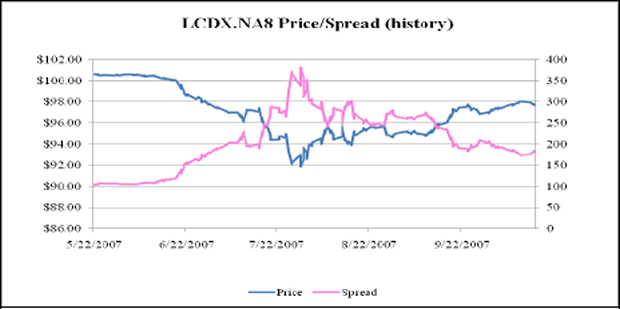
This index was first introduced on May 22 of this year and has subsequently been rolled over into a new LCDX9 index. This index measures the prices of credit default swaps on 100 representative bank loans and was designed to increase market liquidity and ease loan trading. Invented by some of Wall Street's greatest minds, it turned into a kind of Frankenstein monster of volatility that almost consumed its creators during this past summer when dealers began to use it to hedge over $300 billion of LBO loan underwriting commitments. The result was an unprecedented sell-off in bank loan prices as this index became the de facto pricing mechanism for the entire loan market. Historically, non-distressed bank loans had traded in a band of between 97 and 102. Last summer, however, the LCDX8 index sold all the way off to 92 and loan prices followed. The market has since recovered, with the LCDX8 index trading up to above 98 before selling off a bit last week. Consequently, many perfectly good loans dropped in price to the low-90s, something the market had never seen before.
The key point to consider is that this was purely a technical sell-off - loans dropped in price without a corresponding change in the underlying credit quality of the borrowers. Bank loans represent senior secured credit risk, not unsecured credit risk. Even when bank loans default, most ultimately return principal plus accrued interest. For investors who had cash to spend, last summer was a wonderful opportunity to put money to work. Investors who purchased loans in the low-90s have seen prices rebound to the high 90s in a mere two months.
The High Yield Bond Market : The high yield bond market reacted in a similar manner, although unlike the bank loan market, the high yield market has seen previous sell-offs. Graph 2 shows how high yield bond spreads traded well below 300 basis points above their benchmark of 10-year Treasuries earlier in the year before widening to about 450 basis points during the summer meltdown. From a historical standpoint, however, this was a relative non-event. The average spread on high yield has been approximately 515 basis points according to Morgan Stanley,
Graph 2
U.S. High Yield Market Spreads 1990-2007
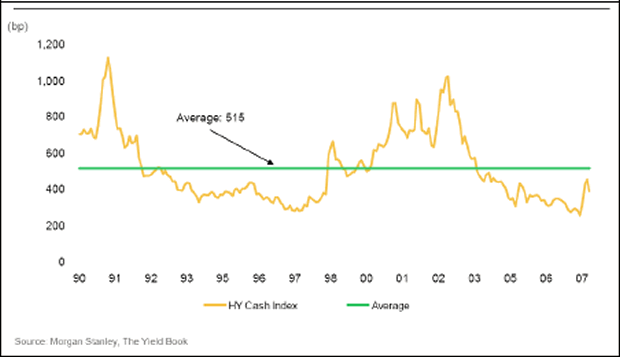
and at points of market crisis spreads have widened out much further to approximately 1000 basis points. A spread of 450 basis points is nothing to get excited about and is hardly a buy signal, though investors who purchased bonds at this level have also been rewarded.
The Structured Credit Market : Of course, the most severe sell-off occurred in the structured credit space this summer. Anything mortgage related basically turned into toxic waste, or was finally recognized as the toxic waste it had always been. It remains to be seen what the recoveries will be on mortgage-related paper, but they likely won't be meaningful. But investors did not stop there. Many of the investors who had purchased the liabilities of Collateralized Debt Obligations (CDOs) holding mortgages also purchased CDOs holding corporate loans, known as Collateralized Loan Obligations or CLOs.
In many cases, the ultimate funders of CLOs were the Special Investment Vehicles, or SIVs, we are reading about having to be bailed out today. It beggars reason to think that we are again seeing the markets being urged by government regulators to bail out private enterprises run by multimillionaires that were leveraged 100 to 1. While the front pages of the financial press were filled with reports about record-sized LBOs, journalists missed the real story - that these large transactions were being financed by a huge shadow economy that was not recorded on the books of any financial institution, was as leveraged as Long Term Capital Management was ten years ago, and was operating completely beyond the reach of regulators. The financial fate of the credit markets was once again left in the hands of a relatively small group of self-interested professionals whose incentives were structured in a way that could best be described as "heads I win, tails you lose." There is nothing tragic about the collapse of the SIVs - their rise and fall can only be described as a farce.
As a result of the fact that SIVs owned structured products backed by mortgages and corporate loans, and the value of their mortgage-backed paper plunged, SIVs were into liquidation. They could not sell mortgage paper because nobody else wanted to buy it, so they sold CLO paper. They also stopped buying newly issued CLO paper, which meant that new CLOs could not be issued. CLOs had been the major source of financing for leveraged buyouts, accounting for far more than half of the demand for leveraged loans used to finance these transactions. All of a sudden the gravy train turned to mush.
Collateralized Loan Obligations : Since the markets reopened after Labor Day, a handful of CLOs have been completed. But as Chart 1 below illustrates, the of capital cost for these vehicles has doubled from an average of 50-60 basis points to approximately 120 basis points. Triple A paper, which constitutes 75 percent of the capital structure of a CLO, costs almost 3 times as much as it did before the markets woke up to the possibility of risk. Triple A spreads are starting to come down - and you should note that triple-A paper in a CLO really is almost riskless - but it is still far more expensive than it was before. I doubt it will break 50 basis points for a long time. The good news, if there is good news, is that the spreads on bank loans have also widened by at least 100 basis points, so the arbitrage that makes these products work by creating the excess spread that produces attractive equity returns is still available. But the future of this product will depend on further tightening of liability spreads and bank loan spreads remaining near current levels.
Chart 1
CLO Spreads - Before and After
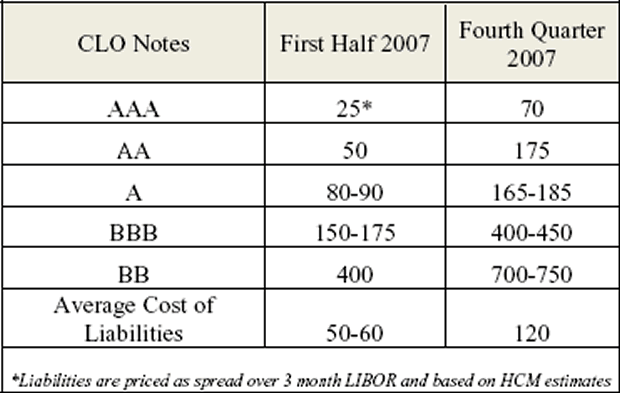
Default Outlook : As I mentioned earlier, throughout all the sound and fury in the financial markets this summer, corporate credit quality remained strong outside of the housing industry. Default rates remain at historic lows, staying below 2% for both bond issuers and bank borrowers. Graph 3 illustrates that default rates continue to scrape along the bottom.
Graph 3
Corporate Default Rates 1985-2007
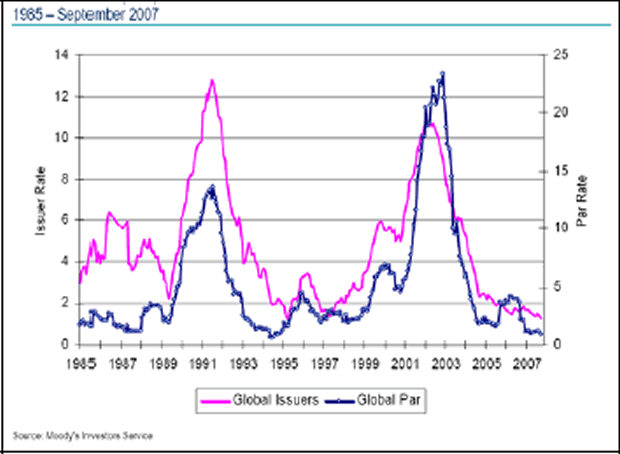
A lot of people have been asking me for the last few years when bond spreads are going to crack. My answer has always been the same - when defaults start to increase. The one thing that scares credit markets more than anything else is defaults. We saw this in 2001 and 2002 when companies that were rated investment grade like WorldCom and Enron defaulted. That is what is so frightening about today's subprime meltdown - investment grade rated tranches of CDOs turned out to be, like WorldCom and Enron, nothing of the sort. When markets lose confidence in credit ratings, as they did with corporate credit ratings in the case of Enron and WorldCom and as they have with AAA tranches of CDOs today, all bets are off. In my experience, many of the SIVs and other investors that purchased CLO and mortgage CDO paper were purchasing ratings and were willfully ignorant about the underlying assets they were financing. Counting on the credit agencies proved to be a costly - and avoidable - mistake.
Chart 2
Complacency Rising
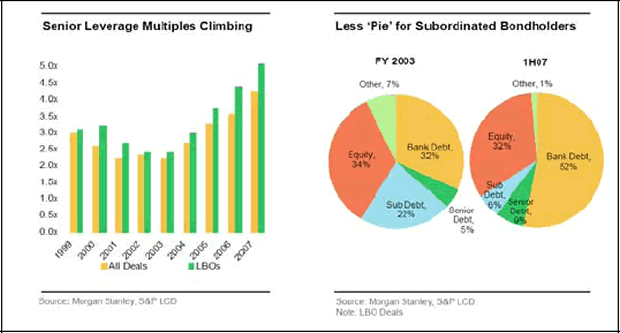
The good news is that outside of the subprime world, corporate credit quality is still pretty strong and has been robust for several years. But as Jim Grant has pointed out so many times in the past, that has only been an invitation to complacency and excess. As Chart 2 on the previous page illustrates, capital structures have become more leveraged as private equity sponsors paid higher prices for target companies over the past couple of years and pushed as much debt onto the backs of subordinated debt holders as the market would allow them.
The result has been a number of egregiously leveraged transactions and an overall increase in corporate balance sheet leverage in the LBO space. This is much more of a problem for smaller cap and mid-cap LBOs and for subordinated debt holders than for senior lenders to large cap companies. Large cap companies, even highly leveraged ones, have a much better chance of handling high levels of leverage - they generally have large market shares, global businesses, and multiple sources of capital that support them through difficult times. Smaller companies may not share these attributes and in a globalized economy are more vulnerable to the types of shocks that a highly leveraged balance sheet can't withstand.
Another sign of market weakness that bears watching is the number of corporate bonds trading down in price. Merrill Lynch has developed something called the High Yield Distress Ratio, which measures the number of bond issues that trade at a spread of greater than 1000 basis points above Treasuries.
Graph 4
Merrill Lynch Distress Ratio 1992-2007
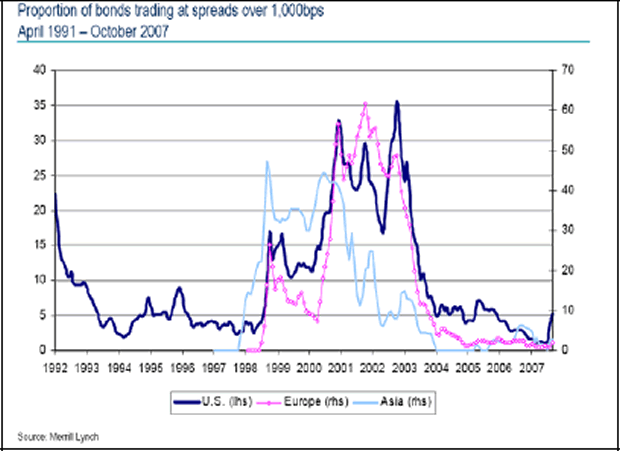
Graph 4 shows how this ratio has started to creep higher in recent months, suggesting that credit trends are starting to weaken at the edges. This is definitely something to keep an eye on, and is consistent with Moody's prediction that the corporate default rate will increase to 3.5 percent by the middle of next year from its current level of under 1.5 percent.
Corporate Credit Market Excesses : There are other excesses in the market that spell trouble ahead. You've read about many of them. The first is covenant-lite loans, which have received a lot of press. Let me make it very simple for everybody - loans without covenants are not loans, and in many cases they are not even bonds. They are equity in disguise because lending money to a small or medium cap company without adequate covenant protections is equivalent to assuming the risk of making an equity investment in the company. Why do these loans exist? Because private equity sponsors are the largest fee payers to Wall Street firms and can demand them, and the buyside is too complacent (that is a euphemism) to argue.
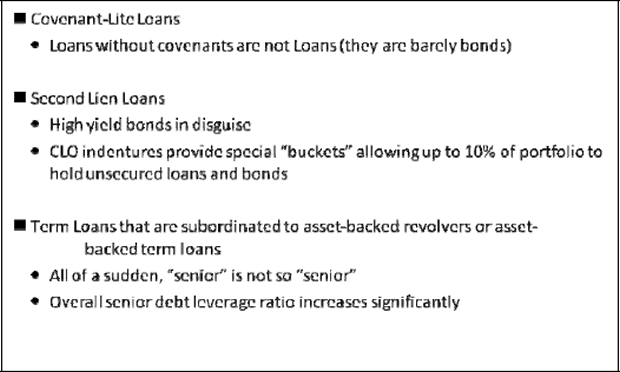
Then there are second lien loans. This is also simple. A piece of paper is not a bank loan simply because someone calls it a bank loan. Second lien loans are high yield bonds in disguise. They are not loans because they are not remotely senior obligations in substance, and the fact that they pay high interest rates is a sure giveaway that they are risky securities, which bank loans are not supposed to be. Many CLOs contain special baskets allowing the vehicle to invest up to 10 percent of its assets in second lien loans and bonds. These baskets are where to look for problems in CLOs.
Then there are deal structures that subordinate so-called senior bank loans to asset-backed revolving lines of credit or other similar facilities. This allows the borrower to hive off much if not all of its tangible collateral so that the so-called senior lenders only obtain access to intangible collateral. Now, intangible collateral in today's world can have a great deal of value, but it's not plant, property and equipment. It is more difficult to value. Moreover, these structures significantly increase the senior debt on a borrower so that cash flow to senior debt coverage is frequently far above what I would consider a conservative 2-3 times and is instead a far more aggressive 5-6 times.
Chart 3
Covenant-Lite Loan Issuance
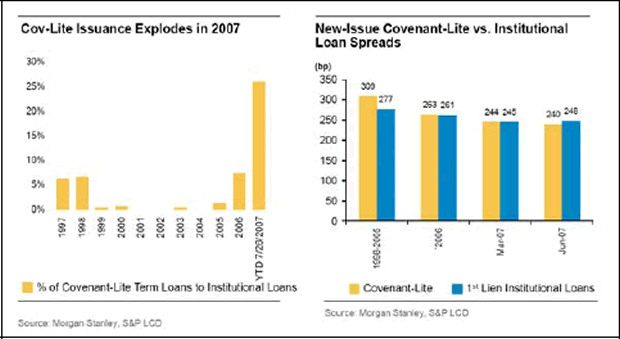
The issuance of covenant-lite loans exploded in 2007. As the left side of Chart 3 above shows, Wall Street can never get enough of a good thing. Moreover, the right side of Chart 3 illustrates that while borrowers started off paying more for the privilege of borrowing without covenants, even that penalty disappeared. Covenant-lite loans are loans that omit the most important limitations a lender can place on a borrower - financial maintenance covenants that require the borrower to maintain the discipline of limiting overall leverage and covering its interest by a certain margin.
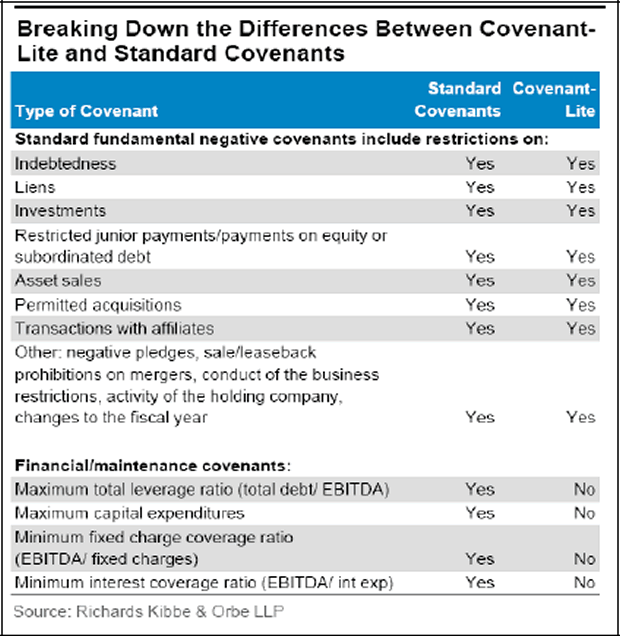
All of these debtor-unfriendly structures remind me of the times I used to go out to dinner with my late grandmother. Wherever we went, even her favorite restaurant, she would always sit down and start complaining about how bad the food was. Then, as soon as the food was served, before she even took a bite, she would start complaining that the portions were too small! That's what I think of each time Wall Street pushes another covenant-lite loan or some other self-serving bad deal on its buyside clients. The clients complain, but they can't seem to get enough.
Market Opportunities and Risks : But complaining isn't a very productive activity. So rather than complain, let's look at the opportunities. And the summer sell-off has left us with some great opportunities.

First, leveraged loans trading below par in companies that are not credit impaired, which means most of the loan universe, remain attractive. These loans used to trade at an average price above par, so they are particularly attractive today at average prices between 96 and 98. Loans tend to have a relatively short average life, which makes them even more attractive.
Second, dealers remain eager to get loans off their books. New deals are still coming at discounts and wide spreads. Large cap deals are particularly attractive for the reasons I stated earlier. It is going to take several more months for the backlog to be worked off.
Third, CLO liabilities are trading at ridiculously wide levels. They offer investment grade risk at junk bond spreads. Moreover, it would take a credit collapse worse than the one we saw in 2001-2002 to impair the BB and BBB bonds of a CLO managed by a good manager, and a credit meltdown that even Jim Grant could not imagine to impair a single or double-A rated CLO piece of paper managed by the worst manager in the business. CLOs are not subprime CDOs.
And there is still a lot of stuff to avoid, or to sell short. High yield bonds are still mispriced, maybe they are terminally mis-priced. Triple-C and single-B bonds trading at below- average spreads should be sold. Second lien loans in highly leveraged companies and covenant- lite loans in small and mid-cap companies should also be avoided. And today, everything can be shorted through credit default swaps or bespoke structures, so the possibilities are endless to express your views on the short side on credit.
Conclusion : To conclude, I would like to borrow from a recent column from Barrons' columnist Michael Santoli, who cited one of my favorite movies, Woody Allen's Crime and Misdemeanors . This is a quote from the movie - "Comedy equals tragedy plus time." Think about it for a moment. Briefly, the film tells the story of Dr. Judah Rosenthal (played by Martin Landau), who arranges for his mistress to be murdered to prevent her from revealing their affair and his commission of some financial improprieties. Judah was raised in a religious Jewish home and is haunted by guilt after the murder. But eventually, as he comes to realize that he is not going to get caught, he returns to his family and his affluent suburban life, and his guilt recedes. There is much more to this great film, but one of the questions Woody Allen seems to be asking is whether we just live in a godless universe where sin goes unpunished.
Now I started my talk with Karl Marx and am ending it with Woody Allen, so many of you probably think I got lost on my way to giving a lecture at the New School. But I am trying to make a point. There is a great deal of talk today about moral hazard in the financial markets. At first it was about the propriety of the government or the Federal Reserve bailing out troubled homeowners. Prominent market participants like PIMCO's Bill Gross have argued, convincingly in my opinion, that if the U.S. government was willing to bail out Mexico, it should be prepared to bail out U.S. homeowners who also happen to be taxpayers. Now people are asking whether the planned M-LEC fund to prop up troubled SIVs is just a disguised bailout of Wall Street, and some have even suggested that it is a disguised bailout of the largest participant in the SIV market, Citibank.
The idea that "comedy is tragedy plus time" really describes many of the processes that we deal with in life. One of the reasons markets are so fascinating is because they mimic life. Many investors can tell you that experiencing investment losses on an emotional level is similar to the experience of grief. Time is an essential element in the healing process. Most good investors can recover their money and their emotional equilibrium if their time horizon for recovery is long enough. That is the challenge facing the credit markets today, particularly the mortgage and housing markets. In my view, housing prices are likely to rise again because the Federal Reserve will continue to lower interest rates and deal with the possible inflationary consequences later. But the housing recovery will be a slow and painful process and the pain is going to be widespread and drawn-out. The corporate credit markets are far healthier. Banks are not rushing to sell off the LBO loans that are burdening their balance sheets because they believe that loans of performing companies will pay them a great deal of interest before they are ultimately sold into less stressed markets.
We have seen slow motion recoveries before. The Japanese were facing a truly difficult economic situation two decades ago, but by adopting incremental reforms and exercising enormous patience, they permitted profound structural economic troubles to morph into a much healthier condition. China is going to have to do the same with its banking system, which remains deeply troubled and will take a long time to repair. But I believe China will follow the Japanese example in solving its banking problem.
SIVs may be unsalvageable simply because they were too highly leveraged; the game now is simply to spread the losses over a long enough period of time that the write-offs can be absorbed without inflicting undue damage to bank balance sheets. The current attempt to form a $100 billion fund to bail out SIVs is another example of trying to turn tragedy into comedy, although it might be better said that it is an attempt to cover up an epic farce. Raising new debt to buy old debt is the oldest game in the business and is often the dumbest. One might call it throwing good money after bad. It is the epitome of Marx's warning about history repeating itself. In this case, the SIVs appear to be filled with toxic mortgage paper that will never recover in value, and the rescue effort may be an exercise in wishful thinking or delaying the inevitable. In either case, those investors who are being asked to invest in M-LEC should beware of salesmen bearing gifts.
Nonetheless, I have seen many portfolios that were broken but were able to blossom because they were allowed the time to heal. Many troubled portfolios do heal with time. Not all, but many. Not all losses are recoverable, but in a large portfolio many things can happen and the overall result can be much better than what was expected. The issue is always whether investors and creditors will give the manager the time to make good on his work. We live in a very impatient and angry culture, which often causes a lot more breakage than is necessary. Some of the hedge funds that failed over the summer would have survived had they been afforded the time to heal, avoiding financial losses and career ruination. Patience really can be its own reward, and I believe our markets are extraordinarily resilient and could really profit from allowing tragedy to mature into comedy with time. As I watch investors make the same mistakes over and over again, as they did again this summer, I sometimes ask myself if they will ever learn to avoid these mistakes. But I know that as long as humans are human, the answer is no. Markets will always veer between tragedy and farce.
Your searching for investment opportunities in the market rubble analyst,
By John Mauldin
http://www.investorsinsight.com
To subscribe to John Mauldin's E-Letter please click here: http://www.frontlinethoughts.com/subscribe.asp
Copyright 2007 John Mauldin. All Rights Reserved
John Mauldin is president of Millennium Wave Advisors, LLC, a registered investment advisor. All material presented herein is believed to be reliable but we cannot attest to its accuracy. Investment recommendations may change and readers are urged to check with their investment counselors before making any investment decisions. Opinions expressed in these reports may change without prior notice. John Mauldin and/or the staff at Millennium Wave Advisors, LLC may or may not have investments in any funds cited above. Mauldin can be reached at 800-829-7273.
Disclaimer PAST RESULTS ARE NOT INDICATIVE OF FUTURE RESULTS. THERE IS RISK OF LOSS AS WELL AS THE OPPORTUNITY FOR GAIN WHEN INVESTING IN MANAGED FUNDS. WHEN CONSIDERING ALTERNATIVE INVESTMENTS, INCLUDING HEDGE FUNDS, YOU SHOULD CONSIDER VARIOUS RISKS INCLUDING THE FACT THAT SOME PRODUCTS: OFTEN ENGAGE IN LEVERAGING AND OTHER SPECULATIVE INVESTMENT PRACTICES THAT MAY INCREASE THE RISK OF INVESTMENT LOSS, CAN BE ILLIQUID, ARE NOT REQUIRED TO PROVIDE PERIODIC PRICING OR VALUATION INFORMATION TO INVESTORS, MAY INVOLVE COMPLEX TAX STRUCTURES AND DELAYS IN DISTRIBUTING IMPORTANT TAX INFORMATION, ARE NOT SUBJECT TO THE SAME REGULATORY REQUIREMENTS AS MUTUAL FUNDS, OFTEN CHARGE HIGH FEES, AND IN MANY CASES THE UNDERLYING INVESTMENTS ARE NOT TRANSPARENT AND ARE KNOWN ONLY TO THE INVESTMENT MANAGER.
John Mauldin Archive |
© 2005-2022 http://www.MarketOracle.co.uk - The Market Oracle is a FREE Daily Financial Markets Analysis & Forecasting online publication.


